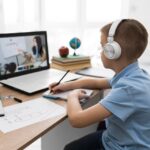
What is Embedded Training and How Will it Benefit your Employee Onboarding?
2 October 2017
Why you should encourage eLearning for your kids
25 October 2017Your sales team will always need product training, and this is a continual process that requires a long-term strategy. This kind of investment requires resources, time, and of course, money. However, all these things are not enough to ensure a successful product training course. There are a variety of issues such as access, location, and knowledge gaps that decision makers need to consider before launching a product training program.
Organisations also need to consider the mobile and digital world. Sales people are always on the go, and forcing them to sit in a training room everyday will affect their sales targets.
So, how can you create an effective product training program where your learners are able to study on the move?
This is where blended learning comes in. You may already have heard of this learning strategy which is a mixture of classroom learning and online learning. This kind of learning is a great asset to any product training course, and here is why:
How to Combine Classroom Training and eLearning
Most organisations have an existing classroom training course that comes complete with a variety of teaching materials. This content can be converted to eLearning easily. Not all aspects of your training can be taught online while some can’t be taught in the classroom.
For example: if you need to present a demo, you can make use of the classroom when;
- Training can be delivered in less than 15 – 30 minutes
- Team based practice and learning is important
You can use online learning when;
- The product being taught hasn’t been launched yet and there are few products to practice with.
- The product is expensive and a face to face demo could damage the product.
You are also able to put your product training into two segments, one for online training and one for classroom training. Always keep these parameters in mind when designing your training course.
| Online Training | Classroom Training |
| Learning can be done by yourself. | Group interaction is needed.
|
| Learners are spread across different locations and experts are not readily available in these locations.
|
Trainers and classrooms are readily available. |
| Products can be easily explained with simulations and videos.
|
Real world practice is necessary for understanding the product. |
| Changes on content are frequent.
|
Content will never be changed. |
| Learners require a safe environment to make mistakes and learn from these mistakes. | Little consequences of failure. |
How to Plan a Blended Learning Approach
By strategically blending these elements, you will create an ideal product training solution.
Before you start your blended learning training, you need to make sure that it is planned perfectly. There are a variety of elements you need to consider when creating a blended learning training plan. There are four primary questions you should ask yourself.
These are:
- What is your learning goal? Is it to create awareness or provide real world insight?
- What kind of content are you providing? Is it based on statistics, does it require video learning or does it require face to face learning.
- Who is your learner? Are they on the go or able to sit in a classroom? Are they experts or beginners?
- What is your learning delivery platform? Are your learners able to work using smart-phones? Does your content have shelf life or need to be consistently updated? Are you converting text book based content into bite-size eLearning content?
Best Practices for Creating the Perfect Blend
- Critical content can be taught face to face while the basics can be taught to learners through eLearning.
- Understand your audience and know who would prefer eLearning and who would prefer classroom learning.
- Don’t judge your training by cost. Do what works best for the learner.
- Be ready to convert your content to online material.
- Test both methods of learning with a test audience.
- Always listen to feedback from your learners.
Keep all of this in mind when developing your blended learning training solution.
Synrgise: Blended Learning Solutions
Synrgise is a world class blended learning and training solution, designed to deliver, monitor, and report on training both online and offline. Synrgise has been built on the foundation of best of breed technologies, ensuring an effective learner management solution that is quick to implement, easy to use, and feature packed.
Taking the entire learner experience into account, we have developed an advanced reporting engine that allows our clients to draw their required reports at the simple click of a button.
The entire system has been designed with the user in mind, making for a learning solution that is empowering, motivating, and successful.
Contact our experts to learn more about how we can help you in your blended learning journey.

